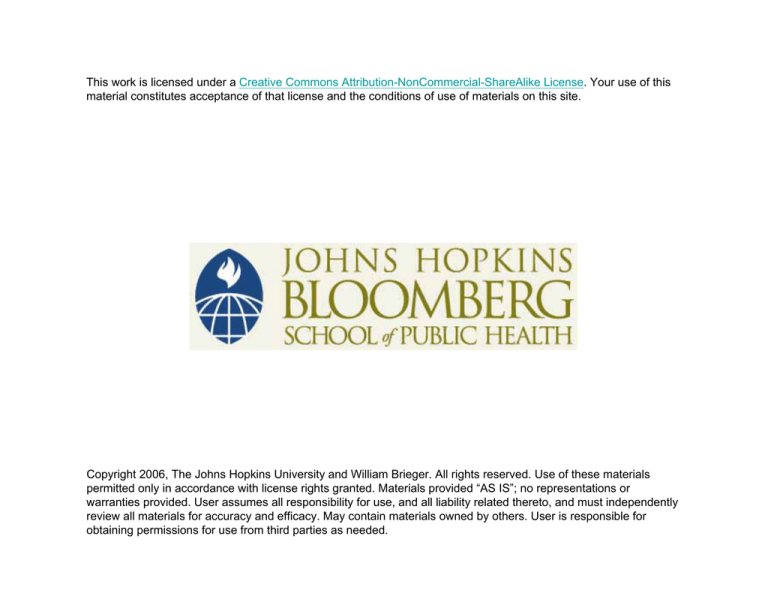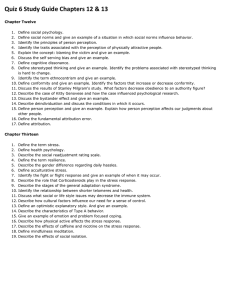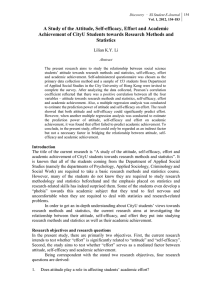
This work is licensed under a Creative Commons Attribution-NonCommercial-ShareAlike License. Your use of this
material constitutes acceptance of that license and the conditions of use of materials on this site.
Copyright 2006, The Johns Hopkins University and William Brieger. All rights reserved. Use of these materials
permitted only in accordance with license rights granted. Materials provided “AS IS”; no representations or
warranties provided. User assumes all responsibility for use, and all liability related thereto, and must independently
review all materials for accuracy and efficacy. May contain materials owned by others. User is responsible for
obtaining permissions for use from third parties as needed.
Using and Making
Models and Theories
William R. Brieger, MPH, CHES, DrPH
Johns Hopkins University
1
Section A
Theory-Based Models
2
Theory-Based Models
Ù
Ù
Ù
Ù
Force field analysis
Health belief model
Social (cognitive) learning theory
Theory of reasoned action/planned
behavior
Ù PRECEDE framework
3
What Is a Model?
Ù A conceptual framework for organizing
and integrating information
Ù A diagrammatic system of
measurement (for example,
mathematical or statistical models)
Ù A theoretical construct that explains
relationships among variables; valued
for predictability
Continued
4
What Is a Model?
Ù An ideal or exemplary program or
method
Ù A simulation of reality in other
dimensions (time, scale)
Continued
5
What Is a Model?
Ù A conceptual structure successfully
developed in one field and applied to
some other field to guide research and
practice (for example, an analogy)
Ù When used interchangeably with the
term theory, the visual representation
of the elements of a theory
6
Characteristics of a Good Theory
Ù A theory should logically explain
existing empirical generalizations and
yield precise and accurate predictions
of new generalizations
Ù It should explain and predict better
than other theories
Ù It should explain empirical findings in
substantive terms, not as artifacts of
the methods employed to obtain them
Continued
7
Characteristics of a Good Theory
Ù It should apply to complex real-life
settings as well as to highly simplified
and tightly controlled research
contexts
Ù It should be generalizable to welldefined and relevant universes and
populations beyond the boundaries of
the particular studies in which it was
built and tested
Continued
8
Characteristics of a Good Theory
Ù It should infer casual relationships
between phenomena being
investigated
Ù It should define those phenomena in
validly measurable terms appropriate
to the explanations and predictions
made
9
Relationships Among
Variables in a Model
Ù Independent→Intermediate→Dependent
Ù Independent
– Age, gender, ethnic group,
occupation
Ù Intermediate
– Knowledge, attitudes, perceptions
Ù Dependent
– Behavior, health status
10
Building Blocks of Theories
Variables and Concepts
Ù Value expectancies
– This may also be termed “attitude
toward a behavior” or “outcome
expectancies” and is a type of costbenefit analysis
– People first need to have some
concept of the potential or likely
consequences of an action
Continued 11
Building Blocks of Theories
Variables and Concepts
– Judgment is made about whether that
consequence or outcome is desirable
or not
– Weigh the advantages / disadvantages
– Perceived efficacy of the proposed
action is another way of looking at this
concept
– Will the action produce a specified
result, and is that result good?
12
Attitudes
Ù An attitude is a disposition toward an
object, person, or situation
Ù This disposition may be favorable or
unfavorable
Ù An attitude may develop from personal
experience or through interaction with
and learning from other important
people in a person’s life
Continued 13
Attitudes
Ù An attitudinal disposition is stimulated
by the presence of or reference to the
object, person, or situation of interest
Ù Behavior of accepting or avoiding an
object is not automatically influenced
by an attitude
Continued 14
Attitudes
Ù It is often the case that more than
attitude is present in a given
circumstance, and, thus, behavior may
be influenced by the stronger or more
pressing attitude
15
Norms and Their Perception
Ù Norms are socially accepted behaviors
or social expectations of desirable
behavior
Ù People belong to reference groups—
people to whom they look to get cues
of what behaviors are acceptable in a
given social situation
Ù Reference groups include, but go
beyond, peer groups
Continued 16
Norms and Their Perception
Ù Perception of norms concerns what
people believe their reference group
expects them to do
Ù People put a value on those
expectations and consider whether or
not they care what other people think
they should do
Continued 17
Norms and Their Perception
Ù People belong to more than one
reference group and may experience
conflicting perceptions of what is
“correct” behavior in a situation
18
Skills Vs. Self-Efficacy
Ù Skills
– The actual ability to perform a task
is the basis of skill
– Skill is mastery of a task both
physically and cognitively
Continued 19
Skills Vs. Self-Efficacy
Ù Self-efficacy
– It is one thing for people to possess
the cognitive and motor skills to
perform a task, and quite another
to have the confidence to carry out
the action
– Self-confidence is also termed selfefficacy
Continued 20
Skills Vs. Self-Efficacy
Ù Self-efficacy
– People gain self-efficacy by
observing others, listening to
encouragement from others, and
by practicing the behavior
themselves
21
Locus of Control
Ù A person’s perception that he/she is
the entity primarily responsible for life
outcomes
Ù In the case of illness, the belief that
one can personally prevent or make a
difference in recovery from sickness
Ù These are issues of control
Continued 22
Locus of Control
Ù External control means that the person
believes that chance, fate, or powerful
people are responsible for life
outcomes
Ù While beliefs about internal control
imply that the person him/herself can
make a difference
23
Perceived Threat
Ù Does a person perceive that there are
specific circumstances that may arise
that could threaten or harm him/her?
Ù This may be broken down into two
components:
– Threat of susceptibility—could it
happen to me?
– Threat of severity—if it happens,
will the consequences be serious?
24
Knowledge and Beliefs
Ù Knowledge
– Recollection of factual information
– But knowledge is culture-bound
– It is possible for people to
memorize facts given at a clinicbased health talk but not believe
them
Ù Beliefs
– Accepted truths or certainties
25
Enabling Factors
Ù The physical and material resources
needed to perform a behavior are
known as enabling factors
Ù These may include physical access to a
service, possession of the funds needed
to purchase a product, availability of
transportation, and the time needed to
carry out a task
Ù The lack of resources is also termed
barriers
26
Intention
Ù Intention is an intermediate variable
between such factors as attitude or
perceived norms and the actual
behavior
Ù Intention reflects a decision or
willingness to undertake a behavior
and is considered a good predictor of
future performance of that behavior
should the opportunity present itself
27
Section B
Force Field Theory
28
A Basic Model
Force Field
Ù Field theory looks at vectors or forces
working for or against a goal
Ù A straight forward tool for community
level planning
Ù Places all the cards (variables) on the
table
Continued 29
A Basic Model
Force Field
Ù Does not distinguish ‘types’ of forces
or variables
Ù Offers strategy suggestions of
increasing positive and decreasing
negative forces
30
Force Field Theory
Ù Dynamics of driving and restraining
forces toward a goal
–
–
Restraining Forces
–
–
–
+
+
+
+
Driving Forces
Goal
+
31
Sleeping under a bed net
32
Bed Net Force Field
33
Force Field Strategies
Ù
Ù
Ù
Ù
Increase the driving forces
Decrease the restraining forces
Do both
Assess the “changeability” of the
forces to target for increase/decrease
– Easy to change
– Resources available
– Others will support, etc
34
35
Goal: Attending
Antenatal/Prenatal Care (ANC)
Driving forces
+ Enjoy meeting other
women there
+ Get some medicines
(Folic acid,TT vaccine)
++ May protect my baby
++ Maternity center located
nearby
Total +6
Source: The Basics
Continued 36
Goal: Attending
Antenatal/Prenatal Care
Restraining forces
– – Costs money to register
– If you go too early, may expose
pregnancy
– – Mother-in-law won’t support idea
– – – Takes time away from the work/market
– Injections may cause infertility
– Nurses often yell at people
37
Goal: Attending
Antenatal/Prenatal Care
Restraining forces
Ù Total –10
Ù Driving – Restraining = – 6
38
39






